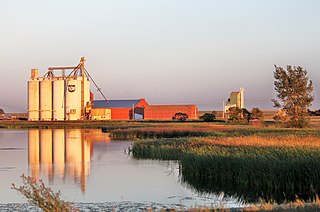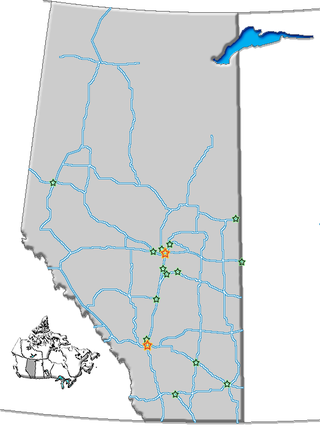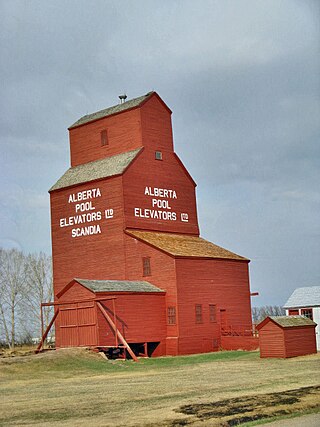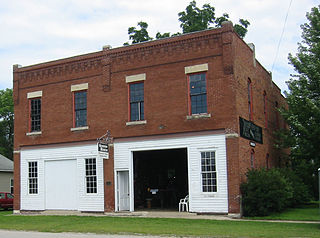
Old Strathcona is a historic district in south-central Edmonton, Alberta, Canada. Once the commercial core of the separate city of Strathcona, the area is now home to many of Edmonton's arts and entertainment facilities, as well as a local shopping hub for residents and students at the nearby University of Alberta. The district centres on Whyte Avenue and has shops, restaurants, bars and buskers.

The Stagecoach Inn Museum in Newbury Park, California, originally known as the Grand Union Hotel, was used as a resting area for people who traveled from Los Angeles to Santa Barbara. Besides a hotel and stagecoach stop, it has also been used as a post office, church, restaurant and military school. It is California Historical Landmark No. 659 and is listed in the National Register of Historic Places. It played a major role in the development of the stage line transportation network in California. The hotel was also the first business venture in the Conejo Valley.

Lacombe is a city in central Alberta, Canada. It is located approximately 25 kilometres (16 mi) north of Red Deer, the nearest major city, and 125 kilometres (78 mi) south of Edmonton, the nearest metropolitan area. The city is set in the rolling parkland of central Alberta, between the Rocky Mountains foothills to the west and the flatter Alberta prairie to the east.

Heart's Content is an incorporated town in Trinity Bay on the Bay de Verde Peninsula of Newfoundland and Labrador, Canada.

Cartwright is an unincorporated urban community in the Cartwright – Roblin Municipality within the Canadian province of Manitoba that held village status prior to January 1, 2015. It was originally incorporated as a village on December 31, 1947.

Raymond is a town in southern Alberta, Canada that is surrounded by the County of Warner No. 5. It is south of Lethbridge at the junction of Highway 52 and Highway 845. Raymond is known for its annual rodeo during the first week of July and the large population of members of the Church of Jesus Christ of Latter-day Saints. Raymond is also significant for its connection to the history of the Japanese experience in Alberta. The town has a rich history in high school sports, basketball, Canadian football, Judo and women's rugby. Raymond was recently mentioned as one of the first communities in Alberta to become a net-zero solar-powered community, after having installed solar panels on most town buildings.

Pioneer Acres Museum is an agricultural and industrial museum located just north of Irricana in Rocky View County in southern Alberta, Canada. The museum is one of the largest agricultural and industrial history museums in Alberta with a collection of thousands of artifacts. Pioneer Acres Museum shares Alberta stories from the beginning of settlement to present day.

Provincial historic sites of Alberta are museums and historic sites run by the Government of Alberta.

The Cook Blacksmith Shop is a former blacksmith shop in Ponca, Nebraska, United States that today is a museum.
Mirror is a hamlet in Lacombe County within central Alberta, Canada. It is located at the junction of Highway 50 and Highway 21, approximately 42 km (26 mi) east of Lacombe and 52.2 km (32.47 mi) northeast of Red Deer.

The Georgia State Railroad Museum is a museum in Savannah, Georgia located at a historic Central of Georgia Railway site. It includes parts of the Central of Georgia Railway: Savannah Shops and Terminal Facilities National Historic Landmark District. The complex is considered the most complete antebellum railroad complex in the United States. The museum, located at 655 Louisville Road, is part of a historic district included in the National Register of Historic Places.

The Strathcona Public Building, Old Strathcona Post Office, South Side Post Office or South Edmonton Post Office is restored heritage building in Strathcona Square in the Old Strathcona heritage district of Edmonton. The restored building along with a Festival Market was opened to the public on the first weekend of September 1988 and the place came to be known as Strathcona Square.

The Scandia Eastern Irrigation District Museum is an open-air museum in Southern Alberta, Canada. The museum includes a historic 1925 Alberta Wheat Pool grain elevator, Bow Slope Stockyard, and displays of how irrigation has affected the prosperity of the area. The museum is part of Eastern Irrigation District Historical Park, which also includes a blacksmith shop, barn, general store, stock yards and river ferry.

The nonprofit Ferndale Museum, located in Ferndale, California, houses and exhibits artifacts, documents and papers from settlement during the California Gold Rush to the present including an active Bosch-Omori seismograph. The area of collection covers the lower Eel River Valley as far south as the Mattole River Valley and west to the Pacific Ocean. Collections include over 8,000 photographs, back issues of the Ferndale Enterprise newspaper, and family papers spanning 150 years.

Chain Bridge Forge is an early 19th-century blacksmith's workshop, on High Street, Spalding, Lincolnshire, England.
The Flatiron building in Lacombe, Alberta is the oldest flatiron building in the province. It was designed by architects Morley Hogle, and Huntley Ward Davis in 1903 and opened for business in 1904. The building served as the Merchants Bank of Canada for many years. For over a century, the famous 'Lacombe flatiron block' was home to many businesses, law offices, and unique shops. Almost one hundred years after the building was erected, it was privately bought and restored as part of the Alberta Main Street Project. Today, this architectural landmark is home to Lacombe Regional Tourism. They offer visitor information, have a local gift shop, and host some information on Lacombe's history.
The Michener House Museum and Archives, located in Lacombe, Alberta, Canada, is an important part of the region's heritage. The house, in which the museum and archives are located, is the birthplace of the Rt. Hon. Roland Michener, Governor General of Canada. The Michener House is also the oldest remaining building in Lacombe. Today, the Lacombe & District Historical Society operates both the museum and archives.

Quasdorf Blacksmith and Wagon Shop, now known as the Quasdorf Blacksmith and Wagon Museum, is a historic building located in Dows, Iowa, United States. The shop was built in 1899 and remained in continuous use until 1990 when Frank Quasdorf willed the building to the Dows Historical Society. The building was restored and reopened as a museum. Displays include machines, tools, belt-driven and electric welding equipment, original wagon wheels, blacksmithing items, a forge and the bellows. Many of the items on display are original to the building and the Quasdorf family.

Cartwright–Roblin Municipality is a rural municipality in the Canadian province of Manitoba.
The Green Family Forge is a two-storey, wooden, heritage-designated blacksmith shop located at the intersection of West Street at Dandy Lane in Trinity, Trinity Bay, Newfoundland and Labrador.

















